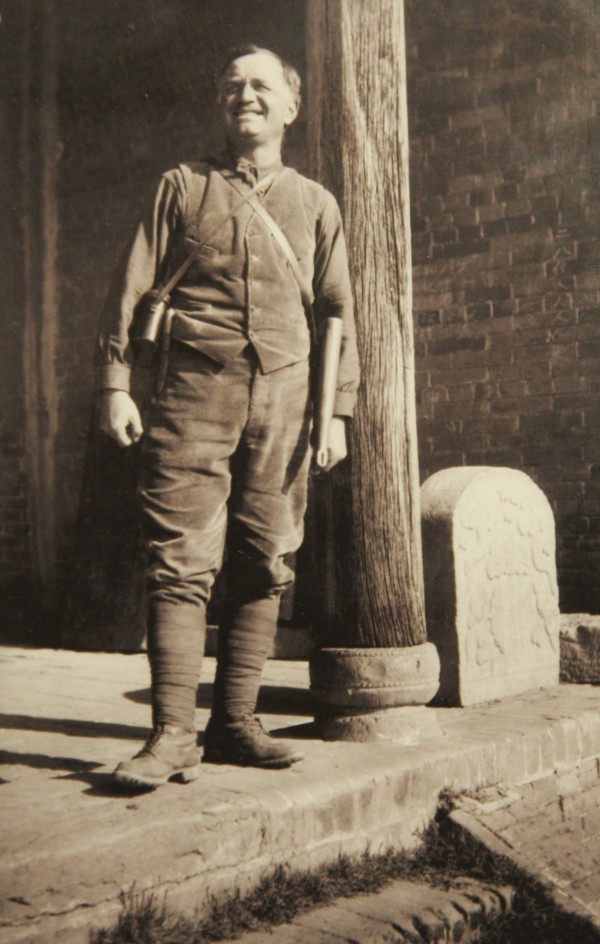
J. G. Andersson "Kina-Gunnar", Geologist and archeologist, in the field, at work in Henan province in 1918. Introduced modern techniques of prehistoric archaeology to China. Working for the Chinese Geological Survey in the 1920s he led the team that discovered Peking Man (Homo erectus) at Zhoukoudian, southwest of Beijing, and the Neolithic site at Yangshao, in Shanxi.
Photo courtesy East Asian Museum, Stockholm.
Johan Gunnar Andersson (July 3, 1874-October 29, 1960) was a geologist born in 1874 in Knista and died in 1960 in Stockholm, Sweden. Since childhood, Anderson was interested in studying fossils, and it was through collecting fossils that he found his happiness. In college, he studied geology and archeology diligently. His love for geology made him the director of Sweden's Geological Survey as well as an influential and renown scientist.
In 1914 he was invited to China as mining adviser to the Chinese Department of Agriculture and Commerce. His affiliation was with China's National Geological Survey (Dizhi diaochasuo) which was organized and led by the extraordinary Chinese scholar Ding Wenjiang (V.K. Ting). During this time, Andersson helped train China’s first generation of geologists, and also made numerous discoveries of iron ore and other mining resources, as well as discoveries in geology and paleontology.
The Iron Ore Resources of the World, which was compiled by Andersson and his successful presentation at the 11th International Geological Conference greatly impressed the Chinese government. Andersson brought new blood to the Chinese mining industry upon his arrival. Soon under his guidance, mines were found, which made the Chinese government ecstatic. It was also around that time that Anderson had a new interest in paleontology after his excavation in the western Henan Province. The excavation led to the discovery of some dinosaur bones, which made him realize that China was filled with hidden ancient fossils and artifacts.
Andersson paid his first visit to Zhoukoudian in 1918 drawn to an area called Chicken-bone Hill by locals who have misidentified the rodent fossils that are found in abundance there. He returned in 1921 and was led by local quarrymen to Dragon Bone Hill where he identified quartz that was not local to the area. Realizing that this may indicate the presence of prehistoric man he set his assistant, Otto Zdansky, to work excavating. Zdansky returned for further excavations in 1923 and a great deal of material was shipped to Uppsala for analysis. Eventually in 1926, on the occasion of a visit by the Swedish Prince to Beijing, Andersson announced the discovery of two human teeth. These are later identified as being the first finds of Peking Man.
While continuing his enquiries and efforts he then discovered prehistoric Neolithic remains in central China’s Henan Province, along the Yellow River. The remains were named Yangshao culture after the village where they were first excavated, in 1921. This too was a highly important breakthrough, since the prehistory of what is now China had not yet been investigated in scientific archaeological excavations and the Yangshao and other prehistoric cultures were completely unknown.
In 1920, Anderson switched his studies of paleontology and geology to archeology. In 1921, the discovery of Yangshao culture marked his position in Chinese archeology. Andersson used his geology, precisely by observing stratigraphic patterns and scanning the landscape to discover the remains of Yangshao culture, which opened the door to studying archeology with technology in China. It was like a revolutionary change. Previously, Chinese archeological findings were based on literature and ancient documents, which did not help to solve many questions, specifically those related to prehistoric culture. These excavations could not be done without technologies and geological/stratigraphy understandings. Anderson was the first to implement his geology understanding and practices, as well as certain archeological methods to discover Yanshou culture.
China became the second home for Johan Gunnar Andersson where he wished to work long-term. He went to many places besides Mianchi, Henan Province to do archaeological research such as Gansu and Qinghai provinces, doing archeological research in the Northwest China. The Chinese government at that time agreed that Andersson took the collections back to Stockholm, doing cataloguing. Today, these findings are collected at the Museum of Far Eastern Antiquities. In 1925, Andersson left China and never came back working again. However, he was always concerned of the development of China's archeology and trained many young archeologists for China.
In 1926, he organized the visit of Crown Prince Gustaf Adolf to China.
In the following years, 1923–24, Andersson, in his capacity as a staff member of China's National Geological Survey, conducted archaeological excavations in the provinces of Gansu and Qinghai, again in collaboration with Chinese colleagues, and published numerous books and scientific papers on Chinese archaeology, many in the Bulletin of the Museum of Far Eastern Antiquities, which he founded and launched in 1929, and where he published his most significant scientific reports on his own work.
Andersson's most well-known popular book on his time in China is Den gula jordens barn, 1932, translated into several languages, including English (as Children of the Yellow Earth, 1934, reprinted 1973), Japanese, and Korean.
A series of discoveries of writing on bone, used in divinations, led to large-scale excavations at Anyang, a capital of the Shang Dynasty, sponsored by Academia Sinica, a national research institute in Taipei, Taiwan, and directed by the Harvard-trained Li Chi and others between 1928 and 1937.
Wartime conditions led to a hiatus in archaeological activity, which was not resumed in a systematic way until 1949.
A